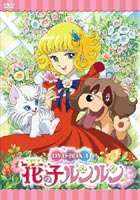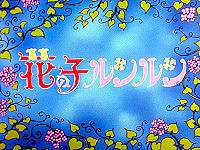Hana no Ko Lunlun
| Hana no Ko Lunlun | |
|
Logo for Hana no Ko Lunlun | |
| 花の子ルンルン (Hana no Ko Runrun) | |
|---|---|
| Genre | Magical girl |
| Anime television series | |
| Directed by | Hiroshi Shidara |
| Written by | Shiro Jinbo |
| Studio | Toei Animation |
| Network | TV Asahi |
| Original run | February 9, 1979 – February 8, 1980 |
| Episodes | 50 |
| Anime film | |
| Hana no Ko Lunlun: Hello Cherry Garden | |
| Studio | Toei Animation |
| Released | March 15, 1980 |
| Runtime | 15 minutes |
Hana no Ko Lunlun (花の子ルンルン Hana no Ko Runrun), translated to English as The Flower Child Lunlun and Lulu, The Flower Angel is a magical girl anime by Toei Animation, focusing on a theme of flowers in its stories. It was directed by Hiroshi Shidara and written by Shiro Jinbo. It was greatly successful in the West, particularly in Europe and in Latin America, as well as in Japan. An edited English-language dub of a few episodes titled Angel made this series one of, if not the first, magical girl anime works to reach the United States, well over a decade before Sailor Moon.
A movie adaptation, Hana no Ko Runrun Konnichiwa Sakura no Sono, was released on March 1980.
In 2009, William Winckler Productions produced two all-new English-dubbed movie versions edited from the original series titled Lun Lun the Flower Girl and Lun Lun the Flower Girl 2. Producer William Winckler, known for Tekkaman the Space Knight, wrote, produced and directed the English films, which are seen on broadband in Japan.
Story
Long ago, plant spirits and fairy-like creatures lived in harmony with mankind. Gradually humans began to rise toward greed and cruelty, and the plant spirits immigrated to another world they dubbed the "Flower Star." However, their legacy remained in people who truly knew the meaning of love and kindness. A talking dog and cat pair, Nouveau and Cateau, were sent to Earth to find one such person to find a magical flower — the symbol of the Flowern Star's ruling family — so that a new ruler can ascend the throne.
In France they meet Lunlun Flower, a shy young orphan who lives with her grandparents who own a flower shop. At Lunlun's 15th birthday party, they ask Lunlun to join them, and she accepts. They travel all over Europe in search of the flower, helping people every step of the way.
Lunlun, Nouveau and Cateau are followed by a bumbling pair of villains: the selfish fairy Togenishia and her servant Yabouki, who want to steal the flower and rule the Flowern Star. Whenever Lunlun and her friends attempt to help people, Togenishia and Yabouki try to get them back on the road by force, only to fail. They're aided by Serge, a mysterious photographer who gives the people Lunlun helps packets of flower seeds which symbolize the lesson they've learned in the "language of flowers." For instance, thistles, which signify independence, are given when the son of a farmer vows to follow his dreams and leave home.
These people all send flower seeds to Lunlun's grandfather and, in the end, the magical flower is found growing in his garden. The photographer turns out to be the prince of the Flower Star who secedes the throne to his younger brother so he can live on Earth and marry Lunlun.
At the start of the series, Lunlun is given a magical pin from the King of the Flower Planet. This pin, when a flower is reflected in its mirror, gives Lunlun a new outfit for an activity, such as mountain climbing. About halfway through the series, the pin is broken when Lunlun falls from a branch overhanging a waterfall while trying to attract attention after being caught in the Dark Wind (Togenishia's main form of attack). While she is lost in the river, a new pin is given to her in the shape of the royal crest, with the warning that if it is ever lost or broken, her life on Earth will end and she will be unable to return to the Flower Planet. The words to activate this pin are "Fu Flay Lu Fey Lora".
Episode list
International titles

- Flower Angel (English dub, U.K.; produced by Harmony Gold/ZIV International)
- Angel (English dub, U.S.; produced by ZIV International)
- Lulú, la Chica de las Flores or En Busca de la Flor Mágica (Castilian Spanish dub)
- Ángel, la Niña de las Flores (Latin American Spanish dub)
- Angel e a flor de 7 cores (Brazilian Portuguese dub)
- Le tour de monde de Lydie (French dub)
- Lulu l'angelo tra i fiori (Italian dub)
- Ейнджъл — детето на цветята (Bulgarian dub)
- Lidia in jurul lumii (Romanian dub)
- Лулу — ангел цветов (Russian dub)
- Lili, a virágangyal (Hungarian dub)
- Lulu, the Flower Girl (Indonesian sub)
- Lulu (Filipino dub)
- Ronron the Flower Angel (English dub, Philippines)
- Saosan, Al Zahrah Al Jamilah (سوسن، الزهرة الجميلة) (Arabic dub)
- Lulu i cudowny kwiat (Polish lector)
- Çiçek Kız (Turkish dub)
- 꽃천사 루루 (Korean dub)
- 花仙子 (Huaxianzi) (Mandarin dub)
- זהבית (Zehavit) (Hebrew dub)
- สาวน้อยแองเจิ้ล (Sao noi Angel) (Thai dub)
- Angel, das Blumenmädchen (German dub)
Reception
In 2005, Japanese television network TV Asahi conducted an online web poll for the top 100 anime, and Hana no Ko Lunlun placed 85th tied with Ikkyū-san.[1]
References
- ↑ "TV Asahi Top 100 Anime". Anime News Network. September 23, 2005. Retrieved December 19, 2012.
External links
- Official site by Toei (Japanese)
- Hana no Ko Lunlun at the Internet Movie Database
- Hana no Ko Lunlun (anime) at Anime News Network's encyclopedia
